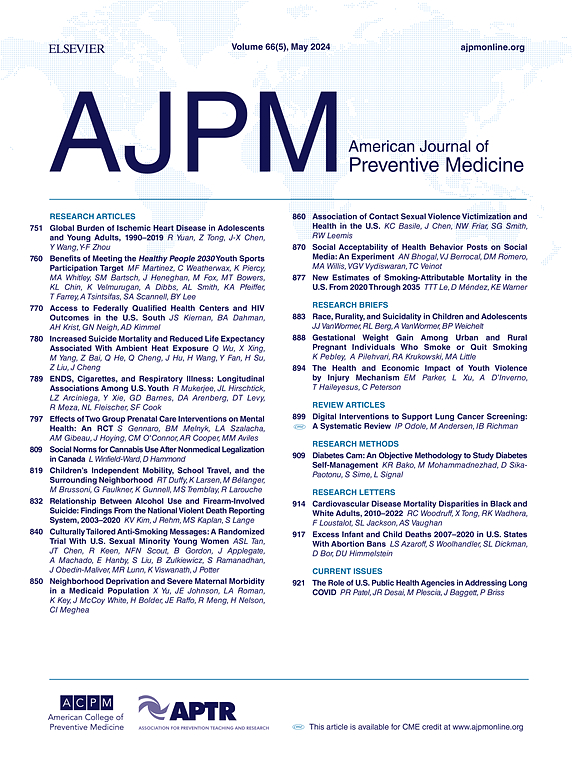Childhood Food Insecurity Trajectories and Adult Weight and Self-Reported Health
IF 4.3
2区 医学
Q1 MEDICINE, GENERAL & INTERNAL
引用次数: 0
Abstract
Introduction
Research has demonstrated that food insecurity during childhood is associated with worse physical and mental health in childhood. However, little is known about how food insecurity during childhood impacts health outcomes in young adulthood.
Methods
This study analyzed data from the Future of Families and Child Wellbeing Study (2024), a longitudinal birth cohort study of children born in 1998–2000. Childhood food insecurity trajectory groups from age 3 to 15 years were identified using group-based trajectory modeling. Associations between childhood food insecurity trajectory groups and young adult weight (BMI, overweight status, and obese status) and high self-reported health (very good/excellent) at age 22 were modeled with multivariate linear and logistic regression.
Results
Three trajectories were identified among 4,296 participants: 66.9% were food secure, 7.5% were food insecure, and 25.6% transitioned from being food insecure-to-secure throughout childhood. In adjusted analyses, young adults assigned to the food insecure-to-secure trajectory group as children had higher BMI (B=0.82, 95% CI=0.07, 1.58) and higher odds of overweight status (OR= 1.24, 95% CI=1.01, 1.52) than young adults assigned to the food secure trajectory group as children. Young adults in the food insecure trajectory group as children had lower odds of high self-reported health than those in the food secure trajectory group as children (OR=0.65, 95% CI=0.48, 0.89).
Conclusions
Food insecurity in childhood is associated with high weight status and poor self-reported health in young adulthood. These findings highlight the importance of childhood food insecurity screening and interventions to promote health throughout the life course.
儿童粮食不安全轨迹与成人体重和自我报告健康。
研究表明,儿童时期的粮食不安全与儿童时期较差的身心健康有关。然而,人们对儿童期粮食不安全如何影响青年期的健康状况知之甚少。方法:本研究分析了来自未来家庭和儿童健康研究(2024)的数据,这是一项对1998-2000年出生的儿童进行的纵向出生队列研究。使用基于群体的轨迹模型确定了3至15岁儿童粮食不安全轨迹组。儿童食品不安全轨迹组与青年体重(BMI、超重状态和肥胖状态)和22岁时高自我报告健康(良好/优秀)之间的关系采用多变量线性和logistic回归建模。结果:在4296名参与者中确定了三种轨迹:66.9%的人粮食安全,7.5%的人粮食不安全,25.6%的人在整个童年时期从粮食不安全过渡到粮食不安全。在调整分析中,与儿童时期食物安全组的年轻人相比,儿童时期食物不安全到安全轨迹组的年轻人BMI更高(B 0.82, 95% CI[0.07-1.58]),超重状态的几率更高(OR 1.24, 95% CI[1.01-1.52])。儿童时期食物不安全轨迹组的年轻人自我报告健康状况高的几率低于儿童时期食物安全轨迹组的年轻人(OR 0.65, 95% CI[0.48-0.89])。结论:儿童时期的粮食不安全与成年后的高体重状况和自我报告的健康状况不佳有关。这些发现强调了儿童粮食不安全筛查和干预措施对促进整个生命过程中的健康的重要性。
本文章由计算机程序翻译,如有差异,请以英文原文为准。
求助全文
约1分钟内获得全文
求助全文
来源期刊

American Journal of Preventive Medicine
医学-公共卫生、环境卫生与职业卫生
CiteScore
8.60
自引率
1.80%
发文量
395
审稿时长
32 days
期刊介绍:
The American Journal of Preventive Medicine is the official journal of the American College of Preventive Medicine and the Association for Prevention Teaching and Research. It publishes articles in the areas of prevention research, teaching, practice and policy. Original research is published on interventions aimed at the prevention of chronic and acute disease and the promotion of individual and community health.
Of particular emphasis are papers that address the primary and secondary prevention of important clinical, behavioral and public health issues such as injury and violence, infectious disease, women''s health, smoking, sedentary behaviors and physical activity, nutrition, diabetes, obesity, and substance use disorders. Papers also address educational initiatives aimed at improving the ability of health professionals to provide effective clinical prevention and public health services. Papers on health services research pertinent to prevention and public health are also published. The journal also publishes official policy statements from the two co-sponsoring organizations, review articles, media reviews, and editorials. Finally, the journal periodically publishes supplements and special theme issues devoted to areas of current interest to the prevention community.
 求助内容:
求助内容: 应助结果提醒方式:
应助结果提醒方式:


